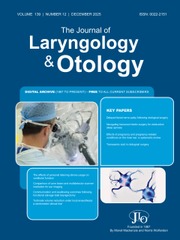No CrossRef data available.
Article contents
Predictive value of peripheral blood eosinophil levels for eosinophilic chronic rhinosinusitis: a systematic review and meta-analysis
Published online by Cambridge University Press: 21 October 2024
Abstract
To evaluate the predictive value of peripheral blood eosinophil levels for eosinophilic chronic rhinosinusitis.
Electronic searches were conducted in PubMed, Embase and the Cochrane Library. Data were analysed using Stata 16.0.
In total, 23 studies that fulfilled the inclusion criteria were analysed. For peripheral blood eosinophil percentage in identifying eosinophilic chronic rhinosinusitis, the pooled sensitivity was 0.77 (95 per cent confidence interval (CI) = 0.69–0.83) and specificity was 0.74 (95 per cent CI = 0.68–0.80), with a positive likelihood ratio of 2.97 (95 per cent CI = 2.38–3.72) and a negative likelihood ratio of 0.31 (95 per cent CI = 0.24–0.42). Similarly, for peripheral blood eosinophil count, the pooled sensitivity was 0.78 (95 per cent CI = 0.73–0.82) and specificity was 0.73 (95 per cent CI = 0.69–0.77), with a positive likelihood ratio of 2.93 (95 per cent CI = 2.45–3.50) and a negative likelihood ratio of 0.30 (95 per cent CI = 0.24–0.37).
There is not sufficient evidence to support peripheral eosinophilia as a good predictor of eosinophilic chronic rhinosinusitis.
- Type
- Review Article
- Information
- Copyright
- Copyright © The Author(s), 2024. Published by Cambridge University Press on behalf of J.L.O. (1984) LIMITED
Footnotes
Changling Sun takes responsibility for the integrity of the content of the paper


